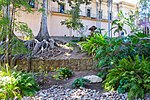Bea Evenson Fountain
1972 establishments in CaliforniaBalboa Park (San Diego)Buildings and structures in San DiegoCalifornia stubsFountains in California ... and 1 more
Monuments and memorials to women

Bea Evenson Fountain is an outdoor fountain in San Diego's Balboa Park, in the U.S. state of California.Designed by noted modernist architect Homer Delawie, the fountain honors Bea Evenson (1900–1981), the founding president of the park's Committee of 100, organized in the late 1960s to save or reconstruct the buildings of the Panama–California Exposition of 1915.Built in 1972 on the Plaza de Balboa, the fountain was dedicated to Evenson in May 1981.
Excerpt from the Wikipedia article Bea Evenson Fountain (License: CC BY-SA 3.0, Authors, Images).Bea Evenson Fountain
Plaza de Balboa, San Diego
Geographical coordinates (GPS) Address Nearby Places Show on map
Geographical coordinates (GPS)
| Latitude | Longitude |
|---|---|
| N 32.73147 ° | E -117.14682 ° |
Address
Bea Evanson Fountain
Plaza de Balboa
92134 San Diego
California, United States
Open on Google Maps










